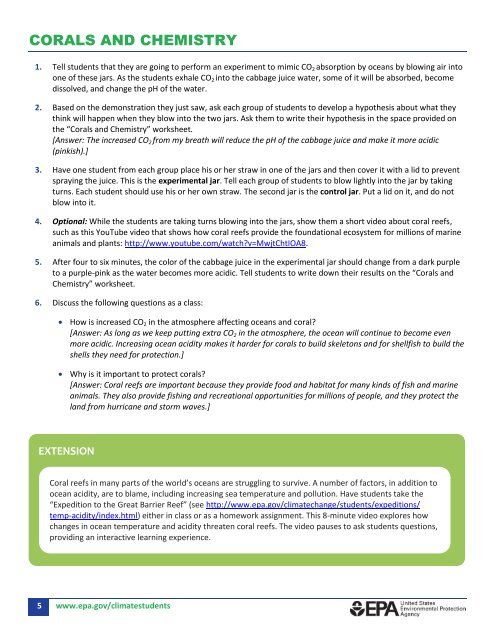Corals and Chemistry - Climate Change Lesson Plan
Corals and Chemistry - Climate Change Lesson Plan
Corals and Chemistry - Climate Change Lesson Plan
Create successful ePaper yourself
Turn your PDF publications into a flip-book with our unique Google optimized e-Paper software.
CORALS AND CHEMISTRY<br />
1. Tell students that they are going to perform an experiment to mimic CO 2 absorption by oceans by blowing air into<br />
one of these jars. As the students exhale CO 2 into the cabbage juice water, some of it will be absorbed, become<br />
dissolved, <strong>and</strong> change the pH of the water.<br />
2. Based on the demonstration they just saw, ask each group of students to develop a hypothesis about what they<br />
think will happen when they blow into the two jars. Ask them to write their hypothesis in the space provided on<br />
the “<strong>Corals</strong> <strong>and</strong> <strong>Chemistry</strong>” worksheet.<br />
[Answer: The increased CO 2 from my breath will reduce the pH of the cabbage juice <strong>and</strong> make it more acidic<br />
(pinkish).]<br />
3. Have one student from each group place his or her straw in one of the jars <strong>and</strong> then cover it with a lid to prevent<br />
spraying the juice. This is the experimental jar. Tell each group of students to blow lightly into the jar by taking<br />
turns. Each student should use his or her own straw. The second jar is the control jar. Put a lid on it, <strong>and</strong> do not<br />
blow into it.<br />
4. Optional: While the students are taking turns blowing into the jars, show them a short video about coral reefs,<br />
such as this YouTube video that shows how coral reefs provide the foundational ecosystem for millions of marine<br />
animals <strong>and</strong> plants: http://www.youtube.com/watch?v=MwjtChtIOA8.<br />
5. After four to six minutes, the color of the cabbage juice in the experimental jar should change from a dark purple<br />
to a purple-pink as the water becomes more acidic. Tell students to write down their results on the “<strong>Corals</strong> <strong>and</strong><br />
<strong>Chemistry</strong>” worksheet.<br />
6. Discuss the following questions as a class:<br />
How is increased CO 2 in the atmosphere affecting oceans <strong>and</strong> coral?<br />
[Answer: As long as we keep putting extra CO 2 in the atmosphere, the ocean will continue to become even<br />
more acidic. Increasing ocean acidity makes it harder for corals to build skeletons <strong>and</strong> for shellfish to build the<br />
shells they need for protection.]<br />
Why is it important to protect corals?<br />
[Answer: Coral reefs are important because they provide food <strong>and</strong> habitat for many kinds of fish <strong>and</strong> marine<br />
animals. They also provide fishing <strong>and</strong> recreational opportunities for millions of people, <strong>and</strong> they protect the<br />
l<strong>and</strong> from hurricane <strong>and</strong> storm waves.]<br />
EXTENSION<br />
Coral reefs in many parts of the world’s oceans are struggling to survive. A number of factors, in addition to<br />
ocean acidity, are to blame, including increasing sea temperature <strong>and</strong> pollution. Have students take the<br />
“Expedition to the Great Barrier Reef” (see http://www.epa.gov/climatechange/students/expeditions/<br />
temp-acidity/index.html) either in class or as a homework assignment. This 8-minute video explores how<br />
changes in ocean temperature <strong>and</strong> acidity threaten coral reefs. The video pauses to ask students questions,<br />
providing an interactive learning experience.<br />
5 www.epa.gov/climatestudents
















